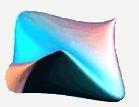|
|
اسپین
|

|
اسپین یک ذره همان تکانه زاویه ای آن ذره است. اسپین ذراتی
که از ذرات دیگر ساخته شده اند، شامل اسپین ذرات سازنده وتکانه زاویه ای
چرخش آن ها به دور یکدیگر است.
اسپین ذرات بنیادی یک خاصیت ذاتی و اساسی است که با
استفاده از حرکات داخلی آن قابل درک وبررسی نیست.
اسپین این ذرات یعنی اسپین ذاتی را باید یکی از کاربردهای پایستگی تکانه
زاویه ای دانست.
|
واحدهای کوانتومی |

|
در نظریه های
کوانتومی تکانه زاویه ای حاصل ضرب یک عدد صحیح در ثابت پلانک تقسیم
بر است.
(2pi)
مقدار h
تقسیم بر(2pi) که
ħ
(اچ بار) نام دارد ، برابر با 6.58 x 10-25
GeV seconds است.
|
فرمیون و بوزون |

|
ذرات
بنیادی بر اساس اسپینشان به دو دسته تقسیم می شوند:
 بوزون
ها: ذراتی که اسپین آن ها حاصل ضرب
یک عدد صحیح در
ħ
است. بوزون
ها: ذراتی که اسپین آن ها حاصل ضرب
یک عدد صحیح در
ħ
است.
 فرمین
ها : ذراتی که اسپین آن ها حاصل ضرب یک عدد فرد در2/ħ
است.
فرمین
ها : ذراتی که اسپین آن ها حاصل ضرب یک عدد فرد در2/ħ
است.
(1/2، 2/3 ، 2/5 و...) برای
مطالعه بیشتر به
اعداد اصلی و
اسپین مراجعه کنید
فرمیون ها از قانون طرد پائولی پیروی می کنند: دو فرمیون
با اسپین یکسان در یک زمان نمی توانند در یک مکان باشند. احتمالا شما با
این قانون برای الکترون ها در اتم آشنا هستید.
بوزون ها از این قانون پیروی نمی کنند. در واقع شرایطی را
که ذرات زیادی دریک حالت باشند را ترجیح می دهند. به عنوان مثال پرتو لیزر
از فوتون های یکسان تشکیل می شود.
ذرات جرم دار :
کوارک ها
و لپتون ها
ذراتی با اسپین 1/2 واحد اسپین (ħ
) هستند.
باریون ها از تعداد ی فرد کوارک ساخته می شوند ، بنابراین
فرمیون هستند.
حامل
های نیرو :
گلوئون
، W ،
Z و فوتون ، بوزون هایی با 1 واحد
اسپین هستند.
مزون ها
هم نوعی بوزون هستند.
ترجمه:
سحر جلیلی 1385/5/24
Spin
Spin is the
name for the angular momentum carried by a particle.
For composite
particles, the spin is made up from the combination of the spins of
the constituents plus the angular momentum of their motion around
one-another.
For
fundamental particles spin is an intrinsic and
inherently
quantum property, it cannot be understood in terms of
motions internal to the object.
The intrinsic
spin must be included in applications of conservation of angular
momentum.
Quantum Units
In quantum theories all angular momenta due
to motion of one object around another are given as integer
multiples of Planck's constant divided by (2pi). This quantity is
called h-bar and is 6.58 x 10-25 GeV seconds.
Fermions and Bosons
Particles can be divided into two classes on
the basis of their spins.
Fermions obey a Pauli Exclusion Principle
-- no two of the same type can exist in the same state at the same
place and time. You may be familiar with this type of rule for
electrons in atoms.
Bosons do not follow such a rule and, in a
certain sense, favor states with many particles in the same state. For
example, a laser
beam is formed from a "coherent state" of many identical photons.
Matter particles --quarks
and
leptons -- are fermions with 1/2 unit of spin.
Baryons are made from odd numbers of
quarks and so are fermions.
Force carriers --gluons,
W's, Z's, and photons are bosons with 1 unit of spin. Mesons also are
bosons.
|